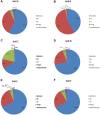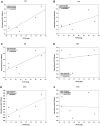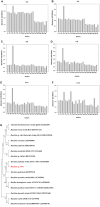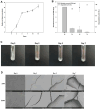Dual Application of p-Nitrophenol Alkanoate-Based Assay for Soil Selection and Screening of Microbial Strains for Bioplastic Degradation
- PMID: 38973389
- PMCID: PMC11294652
- DOI: 10.4014/jmb.2403.03013
Dual Application of p-Nitrophenol Alkanoate-Based Assay for Soil Selection and Screening of Microbial Strains for Bioplastic Degradation
Abstract
With an increase in the commercialization of bioplastics, the importance of screening for plastic-degrading strains and microbes has emerged. Conventional methods for screening such strains are time-consuming and labor-intensive. Therefore, we suggest a method for quickly and effectively screening plastic-degrading microbial strains through dual esterase assays for soil and isolated strains, using p-nitrophenyl alkanoates as substrates. To select microbe-abundant soil, the total amount of phospholipid fatty acids (PLFAs) included in each soil sample was analyzed, and esterase assays were performed for each soil sample to compare the esterase activity of each soil. In addition, by analyzing the correlation coefficients and sensitivity between the amount of PLFAs and the degree of esterase activity according to the substrate, it was confirmed that substrate pNP-C2 is the most useful index for soil containing several microbes having esterase activity. In addition, esterase assays of the isolated strains allowed us to select the most active strain as the degrading strain, and 16S rRNA results confirmed that it was Bacillus sp. N04 showed the highest degradation activity for polybutylene succinate (PBS) as measured in liquid culture for 7 days, with a degradation yield of 99%. Furthermore, Bacillus sp. N04 showed degradation activity against various bioplastics. We propose the dual application of p-nitrophenyl alkanoates as an efficient method to first select the appropriate soil and then to screen for plastic-degrading strains in it, and conclude that pNP-C2 in particular, is a useful indicator.
Keywords: Soil; esterase assay; phospholipid fatty acid; polybutylene succinate; screening method.
Conflict of interest statement
The authors have no financial conflicts of interest to declare.
Figures








Similar articles
-
Application of liquid-based colorimetric method for high throughput screening of bioplastic-degrading strains using esterase assay.Anal Biochem. 2024 Jan 15;685:115390. doi: 10.1016/j.ab.2023.115390. Epub 2023 Nov 10. Anal Biochem. 2024. PMID: 37951454
-
Changes in Soil Microbial Communities Induced by Biodegradable and Polyethylene Mulch Residues Under Three Different Temperatures.Microb Ecol. 2024 Jul 31;87(1):101. doi: 10.1007/s00248-024-02420-0. Microb Ecol. 2024. PMID: 39083238 Free PMC article.
-
Screening and diversity analysis of Dibutyl phthalate degrading bacteria in agricultural soil in Chengdu, China.PLoS One. 2024 Dec 18;19(12):e0310979. doi: 10.1371/journal.pone.0310979. eCollection 2024. PLoS One. 2024. PMID: 39693308 Free PMC article.
-
Revealing the key gene involved in bioplastic degradation from superior bioplastic degrader Bacillus sp. JY35.Int J Biol Macromol. 2023 Jul 31;244:125298. doi: 10.1016/j.ijbiomac.2023.125298. Epub 2023 Jun 12. Int J Biol Macromol. 2023. PMID: 37315675
-
Enhanced production of extracellular triacylglycerol lipase for bioplastic degradation by replacing signal peptide.J Biotechnol. 2025 Jul;403:93-102. doi: 10.1016/j.jbiotec.2025.04.005. Epub 2025 Apr 10. J Biotechnol. 2025. PMID: 40221049
Cited by
-
Discovery of a Novel Bacillus sp. JO01 for the Degradation of Poly(butylene adipate-co-terephthalate)( PBAT) and Its Inhibition by PBAT Monomers.J Microbiol Biotechnol. 2024 Nov 25;35:e2408051. doi: 10.4014/jmb.2408.08051. J Microbiol Biotechnol. 2024. PMID: 39894468 Free PMC article.
References
-
- Kotova IB, Taktarova YV, Tsavkelova EA, Egorova MA, Bubnov IA, Malakhova DV, et al. Microbial degradation of plastics and approaches to make it more efficient. Microbiology (Russian Federation) 2021;90:671–701. doi: 10.1134/S0026261721060084. - DOI
-
- Alshehrei F. Biodegradation of synthetic and natural plastic by microorganisms. J. Appl. Environ. Microbiol. 2017;5:8–19.
MeSH terms
Substances
LinkOut - more resources
Full Text Sources
Miscellaneous

